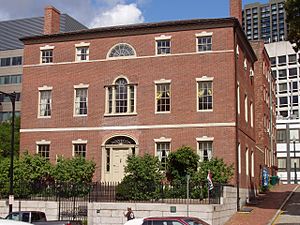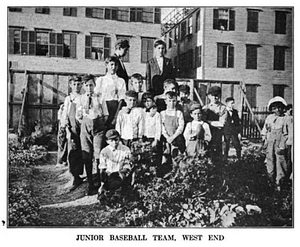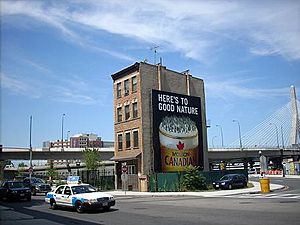West End, Boston facts for kids
Quick facts for kids
West End
|
|
|---|---|

2007 view from the west, with former
Charles Street Jail buildings at right |
|
| Country | United States |
| State | Massachusetts |
| County | Suffolk |
| Neighborhood of | Boston |
| Time zone | UTC-5 (Eastern) |
| Area code(s) | 617 / 857 |
The West End is a neighborhood in Boston, Massachusetts, in the United States. It is located near the Charles River and borders other famous Boston areas like Beacon Hill and the North End. In the late 1950s, a big city project called urban renewal changed much of the West End. This project removed many homes and caused over 20,000 people to move out. Today, the West End has many tall office and residential buildings, along with parts of Massachusetts General Hospital. New homes and parks are also being built.
Contents
Where is the West End?
The West End is in the northwest part of the Shawmut Peninsula. A lot of the land here was actually created by filling in water. Starting in 1807, parts of Beacon Hill were used to fill a small bay. This connected the West End and Beacon Hill to the North End.
Today, the neighborhood has large blocks with tall apartment buildings. The West End is next to the Charles River, between the Longfellow Bridge and the Charles River Dam Bridge. There's a park called Charlesbank Playground along the river. However, a large road called Storrow Drive separates the park from the rest of the neighborhood.
How the West End Began

In the late 1700s and early 1800s, Boston's waterfront and North End became very crowded. Many wealthy people decided to build homes in the area now known as the West End. At that time, a small bay separated this area from the older parts of the city.
A famous architect named Charles Bulfinch helped design many buildings in Boston during this time. He played a big part in developing the West End. Bulfinch designed many grand homes, including the First Harrison Gray Otis House. This historic building was the first of three homes Bulfinch designed for the rich lawyer Harrison Gray Otis. It is one of the few buildings that survived the big changes of the 1950s.
Bulfinch also designed the domed granite building for Massachusetts General Hospital (built 1816–1825), now called the Bulfinch Pavilion. He also designed the West End Market in 1810, which is no longer there. Bulfinch's new brick buildings with gardens attracted many of Boston's wealthiest citizens. By 1810, the West End was home to rich business people, merchants, and lawyers. However, many soon moved to nearby Beacon Hill. This led to the West End becoming a community for African Americans and new immigrants.
Another old West End building is the Charles Street Jail (built in 1851). It was designed by Gridley James Fox Bryant. This jail has since been turned into the Liberty Hotel.
The West End House Community Center
The West End House started in 1906 as a community center for young immigrant boys. A kind person from Boston named James J. Storrow helped fund it. For over 60 years, the West End House was a lively place for social life in the West End. It welcomed young immigrant boys from many different countries.
When the city made big changes to the West End in the 1950s and 1960s, many immigrant families had to move. This meant fewer boys could go to the West End House. In 1971, thanks to people who used to go there, the West End House moved to Allston-Brighton. It became a modern center for both boys and girls, focusing on arts, school, sports, and leadership skills.
A Diverse History
African American Community
In the early 1800s, the West End and the north side of Beacon Hill became important centers for Boston's African American community. Many wealthy white people on Beacon Hill supported the movement to end slavery, known as abolitionism. This encouraged free African Americans to move to the nearby North Slope and West End.
After the Civil War, the West End continued to be a key place for African American culture. It was one of the few places in the U.S. where African Americans had a say in politics. From 1876 to 1895, at least one black resident from the West End served on Boston's community council every year.
Immigrant Stories
From the late 1800s to the mid-1900s, Boston's West End became home to many different immigrant groups. Most of the wealthy residents had left, but many African Americans stayed. This made the neighborhood one of Boston's most diverse places.
Many groups came to live here, including Armenians, Greeks, Irish, Lebanese, Italians, Jews, Lithuanians, Poles, Russians, Syrians, and Ukrainians. The neighborhood's population reached its highest point during this time, with about 23,000 residents.
Because of all these new people, the religious makeup of the West End changed a lot. Protestant churches either moved or closed. In their place, Catholic churches and synagogues opened. For example, the old West Church, built in 1806, closed in 1892. It reopened two years later as a library to better serve the new community.
Irish Immigrants
Irish immigrants were among the first to settle in the West End. After a short time in the North End, many Irish families moved to the West End. Soon, a strong Irish community grew there.
This community later became connected with Martin Lomasney. Lomasney, also known as "the Mahatma," was a powerful local leader in the West End. He was known for helping the community, especially the Irish families.
Early in his career, Lomasney started the Hendricks Club in the neighborhood. It began as a social club, but later became the center of Lomasney's political work. From here, he provided help like social services, charity, and shelter for poor immigrants. In return, he gained many votes and support from the neighborhood.
Jewish Community
By the late 1800s and early 1900s, fewer Irish immigrants were arriving. Instead, many Eastern European Jews began to move into the West End. Many came to escape unfair treatment in Lithuania, Russia, and Poland. They formed a community in the West End and became a large part of the population by 1910.
They built health centers, libraries, labor unions, loan groups, orphanages, and synagogues. The famous actor Leonard Nimoy grew up in this community. Today, the new Boston Synagogue, the 1919 Vilna Shul, and the African Meeting House are the only surviving synagogues or former synagogues in the West End. The Vilna Shul is now a museum. It has pews saved from the former Twelfth Baptist Church, where former African American slaves and soldiers from the 54th Massachusetts Infantry Regiment once sat.
The West End's Big Change
By the 1950s, Boston's West End was a working-class neighborhood with small, winding roads, much like the North End. Most residents felt it was a good place to live. The neighborhood was becoming less crowded, and the population had dropped to about 7,500 people. However, by the end of the 1950s, more than half of the neighborhood was completely torn down. This was part of a huge urban renewal project.
How the Project Happened
As part of a plan to create a "New Boston," the Boston Housing Authority (BHA) and later the Boston Redevelopment Authority (BRA) changed neighborhoods throughout the 1950s and 1960s. The goal was to replace areas classified as slums with new neighborhoods that would bring in more tax money. Before the project, the West End brought in about $546,000 in taxes each year.
The West End redevelopment was announced on April 11, 1953. The mayor and the BHA said the project would help the neighborhood. They claimed the narrow streets were a fire danger and many buildings were old. They promised that new, affordable homes would be found for the residents. Many people believed they would be able to move back to the West End after the project was finished.
The plan involved tearing down a 46-acre (190,000 m²) part of the West End. This meant 2,700 families had to move out. Only 5 new tall apartment buildings with 477 apartments were planned. These new homes were for wealthier residents, so most of the displaced families could not afford to return.
In October 1957, the BRA held a meeting about the project. At least 200 West End residents attended, and most were against the plan. A group called the "Save the West End committee" was formed to protest. However, many residents thought the project would not actually happen, so they did not act until it was too late.
Residents received their eviction letters on April 25, 1958. The BRA used a law called the Housing Act of 1949 to tear down the West End. Working-class families were forced to leave their homes. The old street layout was replaced with large blocks. The result was a neighborhood with tall apartment buildings, shopping centers, and parking lots.
The West End Today

Today, the West End is a mix of businesses and homes. A few areas were saved from the 1950s changes, like Massachusetts General Hospital, the Charles Street Jail, and the Bulfinch Triangle. Massachusetts General Hospital and the Charles Street Jail are in the northwest. Government Center, which used to be Scollay Square, is in the southern part. Most of the northern section has North Station and the TD Garden.
The old feel of the area before the big changes can still be seen in the buildings of the Bulfinch Triangle. Here, you can find some pubs and restaurants. The new residential areas are mostly fancy tall buildings. However, the neighborhood is working to bring back the close-knit community it once had. The West End Museum has a permanent exhibit about the history of the neighborhood and its residents. The West End Community Center offers classes and events, and also hosts the yearly West End Children's Festival.
42 Lomasney Way
One building that survived the West End's redevelopment is 42 Lomasney Way. Built in the 1870s, this building made it through many attempts to tear it down and even two fires. It is called "The Last Tenement" because it is the only old apartment building still left in the West End. It was also once home to an associate of a well-known family.
Notable People from the West End
- Jules Aarons (1921–2008), a photographer known for his pictures of the West End.
- Jennie Loitman Barron (1891–1969), a lawyer and judge who supported women's right to vote.
- Leonard Nimoy (1931–2015), a famous actor.
- Harrison Gray Otis (1765–1848), a politician.
- Sumner Redstone (1923-2020), a media leader.
- Ruth Roman (1922–1999), an actress.
- Josephine St. Pierre Ruffin (1842–1924) and her daughter Florida Ruffin Ridley (1861–1943), who worked for civil rights.
- David Walker (1796–1830), who worked to end slavery.







